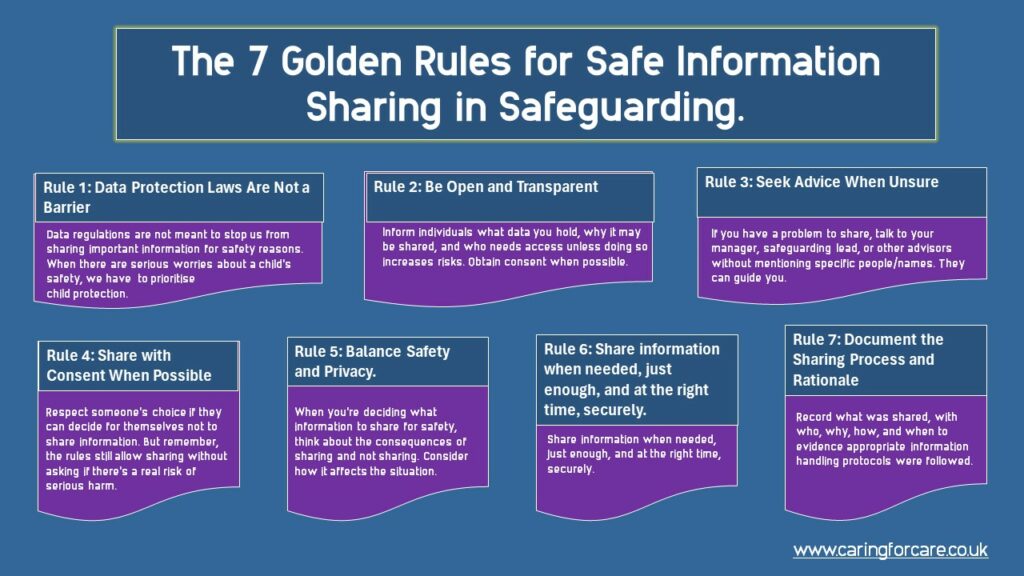The 7 Golden Rules for Safe Information Sharing in Safeguarding
Estimated reading time: 8 minutes

When handling private information about individuals, particularly children, safeguarding professionals must strike a balance between protection and privacy. These 7 fundamental rules provide ethical guidance to ensure necessary sharing is done lawfully to prevent abuse. Real-world case examples illustrate how to apply each principle correctly.
What we covered:
- Rule 1: Data Protection Laws Are Not a Barrier.
- Rule 2: Be Open and Transparent.
- Rule 3: Seek Advice When Unsure.
- Rule 4: Share with Consent When Possible.
- Rule 5: Balance Safety and Privacy.
- Rule 6: Share Information in a Necessary, Proportionate, Relevant, Timely and Secure Manner.
- Rule 7: Document the Sharing Process and Rationale.
Rule 1: Data Protection Laws Are Not a Barrier
Data regulations are not intended to prevent the sharing of relevant details for safety purposes; however, child protection takes precedence when serious concerns exist.
The primary laws for safeguarding data include the General Data Protection Regulation (GDPR) in Europe and the Data Protection Act 2018 in the UK.
Remember Safety comes first
- The well-being of individuals, whether they are adults or children, should be the primary consideration when sharing information that could identify them.
- Only share what is really needed to keep them safe – nothing extra.
- Example: A teacher emails the school counselor precise student statements about possible abuse at home so counselor can advise on duty to report.
Case Example:
Simon, a social worker, learns 14-year-old Cara confided suicidal thoughts to her teacher. The teacher referred Cara to counseling per policy. Simon requests her counseling intake records to assess Cara’s safety risks and needs. This information exchange between school and social services is permissible due to the serious mental health concerns. Simon documents the rationale for requesting records related to Cara’s wellbeing.
Rule 2: Be Open and Transparent
Inform individuals what data you hold, why it may be shared, and who needs access unless doing so escalates risks. Obtain consent when possible.
Be open and honest about why you need to share.
- Clearly explain to individual why information sharing is needed and who you are sharing the information with unless this puts the individual at more risk.
- Get consent when possible but share if needed to protect the individual.
- Example: A doctor tells parents she must share medical report of injuries with social services to investigate possible abuse.
Case Example:
Aisha’s doctor must share health visit notes with a pediatrician for assessment of suspicious bruising. The doctor explains to Aisha’s mother that sharing limited medical details is necessary for proper diagnosis. She obtained verbal consent to send the pediatrician the physical exam findings associated with the unexplained marks.

The General Data Protection Regulation (GDPR) was incorporated into UK law as the UK GDPR on January 1, 2021. The UK GDPR is essentially the same as the EU GDPR, but there are a few minor differences.
Rule 3: Seek Advice When Unsure
If you have a problem to share, talk to your manager, safeguarding lead, or other advisors without mentioning specific people.
Ensure you only share information according to data protection rules.
- Check organisational policies allow sharing for safeguarding purposes.
- Make sure you have consent if needed.
- Only send personal information in a secure system, not informal networks.
- Example: A therapist submits child counseling notes through formal electronic case management system only accessible to authorised staff.
Case Example:
Eric’s counselor has concerns about his escalating marijuana use. She wants to inform Eric’s parents to get him treatment but Eric refuses consent due to strained family relationships. Unsure, the counselor anonymously describes the situation in supervision to weigh risks of sharing confidentially versus allowing substance issues to progress unchecked.
Rule 4: Share with Consent When Possible
Respect someone’s choice if they can decide for themselves not to share information. But remember, the rules still allow sharing without asking if there’s a real risk of serious harm.
Only share the information needed:
- Do not share everything you know if only parts are relevant to safety issue.
- Remove details not related to the specific concern.
- Example: School shares report of physical injury, not entire record with medical history and grades.
Case Example:
Jacinda denies consent for her social worker to obtain past counseling records. While her history provides useful context, there are no immediate risks requiring information sharing without permission. The social worker respects Jacinda’s choice and continues support services without the additional background.

The most common perpetrators of abuse are family members (38.5%), followed by paid carers (17.5%) and friends or neighbors (10.6%).
Rule 5: Balance Safety and Privacy
Weigh the impacts of sharing versus not sharing details when deciding what information is necessary to share for safety purposes.
Be accurate and up-to-date:
- Make sure all details you share like times, statements, facts are correct.
- Do not share old information that may now be irrelevant or out-of-context.
- Correct any errors discovered later on.
- Example: Daycare provider immediately notifies caseworker of an error in the initial incident report, specifically the incorrect date.
Case Example:
A teacher is asked to share a student’s Individualised Education Plan with an afterschool program. To protect the student’s privacy, the teacher redacts medical diagnoses and background not relevant to the accommodations needed in programming prior to releasing the document.
Rule 6: Share Information in a Necessary, Proportionate, Relevant, Timely and Secure Manner
Share only essential information for protection using secure methods and ensure accuracy.
Share safely and securely:
- Send information in a secure format like password-protected document or encrypted message.
- Verify identity and role before sharing information with professionals.
- Keep limited paper copies secured in locked files only those with a need can access.
- Example: Sending by secure case management portal rather than unencrypted email.
Case Example:
When making a child protection referral regarding possible neglect, a public health nurse only includes the child’s age, concerning home conditions observed, statements made, and risks noted. She sends the referral through the HHS encrypted reporting portal on the same day rather than mailing hard copies.
Rule 7: Document the Sharing Process and Rationale
Record what was shared, with who, why, how, and when to evidence appropriate information handling protocols were followed.
Let people know when you share any information about them:
- Tell individuals if you have shared their personal information when appropriate.
- Do not tell if it puts them at more risk or hampers investigations.
- Example: Therapist lets father know she made a child protection referral with family details due to signs of abuse.
Case Example:
After the principal reports a situation to child protective services, he logs details including the date reported, family members involved, allegations, any witnesses, reasons prompting referral, name of caseworker contacted, and topics discussed.

Image Above: Infographics on the 7 golden rules of information sharing safeguarding
BUY NOW – Data Protection and GDPR Awareness -CPD APPROVED
In Summary
Keeping careful records shows that you care a lot and are really careful.
With care for both safety and privacy, professionals can make lawful information sharing decisions guided by these 7 golden rules of sharing information.
When you face tough choices, talk to the right people, write down everything, and prioritise safety when there’s a real danger.
These 7 rules allow properly managing sensitive information so individuals get needed help while maintaining privacy as much as possible.
Handling details safely takes diligence but protects everyone.
Recent Post Published
- Basic Life Support Checklist -PDF Download Available
- Safeguarding Training Levels: How to choose the right training
- Caring For Care Partners with AquAid to Support Installation of Elephant Pumps in Africa
- Wound Assessment and Documentation: Mastering Key Steps for Better Care
- Understanding Bereavement Support and Duties of Different Healthcare Groups.
Information Sharing FAQs
What are the policies relating to information sharing in safeguarding?
The Policies regarding information sharing in safeguarding typically emphasise the importance of sharing relevant information to ensure the well-being and safety of individuals.
These policies often outline the principles, legal frameworks, and procedures for sharing information responsibly and securely.
What is the key principle of confidentiality and information sharing with regard to safeguarding?
The key principle involves balancing the need to share information for safeguarding purposes while respecting an individual’s right to confidentiality.
It emphasizes sharing information responsibly, ensuring it is relevant, proportionate, and used only for the purpose of safeguarding.
Yes, Principle 7, which highlights the duty to share information for individual care, is crucial.
While patient confidentiality is vital, sharing necessary information is equally important to provide appropriate and timely care, especially in safeguarding situations.
Balancing these duties is essential for effective healthcare.
The Care Act guidance emphasises the importance of information sharing to promote the well-being of individuals.
It highlights the need for collaboration between different agencies and professionals involved in care.
The guidance stresses that information sharing should be person-centered, respecting the individual’s wishes and preferences while ensuring their safety and welfare.
Let us Help you
We’ll help you find the right course for your needs. Tell us a little bit about your situation and what you would like to achieve.
We’ll get back to you within one working day.
